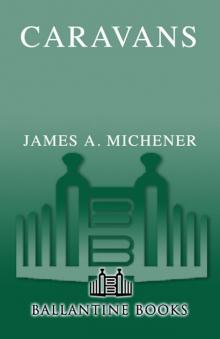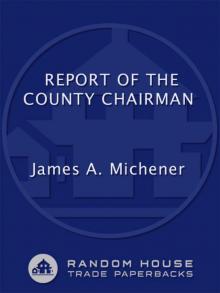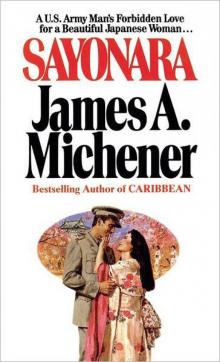- Home
- James A. Michener
Creatures of the Kingdom: Stories of Animals and Nature Page 7
Creatures of the Kingdom: Stories of Animals and Nature Read online
Page 7
Now allosaurus lashed his short tail and emitted growls of frustration. He had killed this animal, which meant a vast amount of food, but could not consume it. Other predators appeared, including the two smaller dinosaurs that had visited the beach before. All remained at a safe distance from allosaurus.
He took one more massive bite from the dead body but could not swallow it. He spit it out, glared at the onlookers, then tried again. Covered with sand, the flesh rested in his gaping mouth for several minutes, then slid down inside the extended neck. With a combative awk-awk rumbling from deep within his throat, allosaurus lunged ineffectively at the watchers, then ambled off to higher ground.
As soon as he was gone, the scavengers moved in—reptiles from the sky, crocodiles from the lagoon, two kinds of dinosaurs from land and the mammals hiding by the gingko tree. By nightfall the dead diplodocus, all thirty-three tons of him, had disappeared and only his massive skeleton lay on the beach.
Wounded diplodocus and the four young dinosaurs that had witnessed this massacre now swam back to the lagoon. In the days that followed she began to experience the last inchoate urge she would ever know. Sharp pains radiated slowly from the place where allosaurus had ripped her. She found no pleasure in association with other members of the herd. She was drawn by some inexplicable force back to the swamp at the chalk cliff, not for purposes of re-creating the family of which she was a part but for some pressing reason she had never felt before.
For nine days she delayed heading for the swamp, satisfying herself with half-sleep in the lagoon, idly poling herself half submerged from one warm spot to another, but the pain did not diminish. Vaguely she wanted to float motionless in the sun, but she knew that if she did this, the sun would destroy her. She was a reptile and had no means of controlling body heat; to lie exposed in the sun long enough would boil her to death in her own internal liquids.
Finally, on the tenth day she entered the river for the last time, stepping quietly like some gracious queen. She stopped occasionally to browse on some tree, lifting her head in an arc on which the late sun shone. Her tail extended behind, and when she switched it for some idle purpose it gleamed like a scimitar set with jewels.
How beautiful she was as she took that painful journey, how gracefully coordinated her movements as she swam toward the chalk cliff. She moved as if she owned the earth and conferred grace upon it. She was the great final sum of millions of years of development. Slowly, swaying from side to side with majestic delicacy, she made her way to the swamp that lay at the foot of the cliff.
There she hesitated, twisting her great neck for the last time as if to survey her kingdom. Thirty feet above the earth her small head towered in one last thrust. Then slowly it lowered; slowly the graceful arc capsized. The tail dragged in the mud and the massive knees began to buckle. With a final surge of determination, she moved herself ponderously and clumsily into a deep eddy.
Its murky waters crept up her legs, which would never again be pulled forth like reeds; this was the ultimate capture. The torn side went under; the tail submerged for the last time, and finally even the lovely arc of her neck disappeared. The knobby protuberance holding her nose stayed aloft for a few minutes, as if she desired one last lungful of the heavy tropical air, then it too disappeared. She had gone to rest, her mighty frame imprisoned in the muck that would embrace her tightly for a hundred and thirty-six million years.
It was ironic that the only witness to the death of diplodocus was the little pantothere that watched from the safety of a cycad tree, for of all creatures who had appeared on the beach, he was the only one that was not a reptile. The dinosaurs were destined to disappear from the Earth, while this little animal would survive, its descendants and collaterals populating the entire world, first with prehistoric mammals, themselves destined to become extinct—titanotheres, mastodons, eohippus—and subsequently with animals man would know, such as the mammoth, the lion, the elephant, the bison and the horse.
Of course, certain smaller reptiles such as the crocodile, the turtle and the snake would survive, but why did they and the little mammal live when the great reptiles vanished? This remains one of the world’s supreme mysteries. About sixty-five million years ago, as the new Rockies were emerging, the dinosaurs and all their immediate relations died out. The erasure was total, and scholars have not yet agreed upon a satisfactory explanation. All we know for sure is that these towering beasts disappeared. Triceratops with its ruffed collar, tyrannosaur of the fearful teeth, ankylosaur the plated ambulating tank, trachodon the gentle duck-billed monster—all unaccountably vanished.
A MIRACLE OF EVOLUTION
Fifty-three million years ago, while the new Rockies were still developing and long after diplodocus had vanished, in the plains area where the twin pillars formed, an animal began to develop that in later times would give man his greatest assistance, as well as pleasure and mobility. The progenitor of this invaluable beast was a curious little creature, a four-legged mammal, and he stood only seven or eight inches high at the shoulder. He weighed little, had a body covering of part-fur, part-hair and seemed destined to develop into nothing more than an inconsequential beast.
He had, however, three characteristics that would determine his future potential. The bones in his four short legs were complete and separate and capable of elongation. On each foot he had five small toes, that mysteriously perfect number that was the same for most of the ancient animals, including the great dinosaurs. And he had forty-four teeth, arranged in an unprecedented manner: in front, some peglike teeth as weak as those of diplodocus; then a conspicuous open space; then at the back of the jaw, numerous grinding molars.
This little animal made no impression on his age, for he was surrounded by other, much larger mammals destined to become rhinoceroses, camels and sloths. He lived in seclusion in the shady parts of such woods as had developed and fed himself by browsing on leaves and soft marsh plants, for his teeth were not strong and would have quickly worn down had they been required to chew rough food like the grass that was then beginning to develop.
If one had observed all the mammals of this period and tried to evaluate the chances of each to amount to something, one would not have placed this quiet little creature high on the list of significant progenitors; indeed, it would have seemed then that the beast might develop in a number of different ways, none of them memorable, and that the little fellow might survive a few million years and then quietly vanish.
The curious thing about this forerunner of greatness is that although we are sure that he existed and are intellectually convinced that he had to have certain characteristics, no man has ever seen a shred of physical evidence that he really did exist. No fossil bone of this creature has so far been found; we have a large collection of bones of diplodocus and her fellow reptiles, all of whom vanished, but of this small prototype of one of the great animal families, we have no relics whatever. Indeed, he has not yet even been named, although we are quite familiar with his attributes; perhaps when his bones are ultimately found—and they will be—a proper name would be paleohippus, the hippus of the Paleocene epoch. When word of his discovery is flashed around the world, scholars and laymen in all countries will be delighted, for they will have come into contact with the father of a most distinguished race, one that all men have loved and from which most have profited.
Perhaps thirteen million years after paleohippus flourished, and when the land that would contain the twin pillars had begun to form, the second in line and first-known in this animal family appeared and became so numerous in the area that hundreds of skeletons would ultimately be laid down in rock. Because of this, scientists would know this small creature as intimately as they know their own puppies.
He was eohippus, an attractive small animal about twelve inches high at the shoulder. He looked more like a friendly dog than anything else, with small alert ears, a swishing tail to keep insects away, a furry kind of coat and a face that was somewhat long in order to accommodate
the forty-four teeth inherited from his ancestor. The teeth were still weak, so that the little creature had to content himself with leaves and other soft foods.
But the thing that marked eohippus and made one suspect that this family of animals might be headed in some important direction was the feet. On the short front feet, not yet adapted for swift movement, the five original toes had been reduced to four; one had only recently disappeared, the bones that had once sustained it vanishing into the leg. And on the rear foot there were now three toes, the two others having withered away during the course of evolution. But the surviving toes had tiny hooves instead of claws.
One could still not predict what this inconspicuous animal was going to become, and the fact that he would stand second in the sixty-million-year process of creating a noble animal seemed unlikely. Eohippus seemed more suited to be merely a family pet.
And then, about thirty million years ago, when the land that was to form the twin pillars was being laid down, mesohippus developed, twenty-four inches high at the shoulders and with all the basic characteristics of his ancestors, except that he had only three toes on each of his feet. He was a sleek animal, about the size of our collie or red fox. The forty-four teeth kept his face long and lean and his legs were beginning to lengthen, but his feet still contained pads and small hooves.
Then, about eighteen million years ago, a dramatic development took place. Merychippus appeared, a handsome three-toed animal forty inches high, with a bristly mane, long face and protective bars behind the eye sockets.
He had one additional development that would enable the horse family to survive in a changing world: his teeth acquired the remarkable capacity to grow out from their socket as they wore down at the crown. This permitted the proto-horse to quit browsing on such leaves as he found and to move instead to grazing on the new grasses that were developing on the prairies. Grass is a dangerous and difficult food; it contains silica and other rough substances that wear down teeth, which must do much grinding in order to prepare the grass for digestion. Had not merychippus developed these self-renewing grinders, the horse as we know it could neither have developed nor survived. But with this almost magical equipment, he was prepared.
These profound evolutions occurred in what is now known as Colorado on the plains that surrounded the site of the twin pillars. There on flatlands that knew varied climates, from tropical to subarctic, depending on where the equator was located at the time, this singular breed of animal went through the manifold changes that were necessary before it stood forth as the horse as we know it.
One of the biggest changes in the antecedents of the horse appeared about six million years ago, when pliohippus, the latest in the breed, evolved with only one toe on each foot and with the pads on which his ancestors had run eliminated. It now had a single hoof. This animal was a medium-sized beautiful horse in almost every sense of the word, and would have been recognized as such, even from a considerable distance. There would be minor refinements, mostly in the teeth and in the shape of the skull, but the horse of historic times was now foreshadowed.
He arrived as equus about two million years ago, as splendid an animal as the ages were to produce. Starting from the mysterious and unseen paleohippus, this breed had unconsciously and with great persistence adapted itself to all the changes that the Earth presented, adhering always to those mutations that showed the best chance of future development. Paleohippus, of the many capacities; eohippus, of the subtle form; merychippus, with the horselike appearance; pliohippus, with the single hoof—these attributes persisted. There were dozens of other variations equally interesting that died out because they did not contribute to the final form. There were would-be horses of every description, some with the most ingenious innovations, but they did not survive, for they failed to adjust to the Earth as it was developing; they vanished because they were not needed. But the horse, with its notable collection of virtues and adjustments, did survive.
About one million years ago, when the twin pillars were well formed, a male horse with chestnut coloring and flowing tail lived in the area as part of a herd of about ninety. He was three years old and gifted with especially strong legs that enabled him to run more swiftly than most of his fellows. He was a gamin by nature and had left his mother sooner than any of the other males of his generation. He was the first to explore new arrivals on the prairie and had developed the bad habit of leading any horses that would follow on excursions into canyons or along extended draws.
One bright summer morning this chestnut was leading a group of six adventurous companions on a short foray. He took them across the plains that reached out from the twin pillars and northward into a series of foothills that contained passageways down which they galloped in single file, their tails flowing behind them as they ran. It was an exhilarating chase, and at the end of the main defile they turned eastward toward a plain that opened out invitingly, but as they galloped they saw blocking their way two mammoths of extraordinary size. Fourteen feet tall at the shoulders, with monstrous white tusks that curved downward from the head, the great creatures towered over the horses. The tips of their tusks reached sixteen feet, and if they caught an adversary, they could toss him far into the air. The two mammoths were imposing, and had they been ill-disposed toward the horses, could have created havoc, but they were placid by nature and intended no harm.
The chestnut halted his troop, led them at a sober pace around the mammoths, coming very close to the great tusks, then broke into a gallop that would take him onto the eastern plains, where a small herd of camels grazed, bending awkwardly forward. The horses ignored them, for ahead stood a group of antelope as if waiting for a challenge. The seven horses passed at full speed, whereupon the fleet antelope, each with a crown of four large antlers, sprang into action, darting after them.
For a few moments the two groups of animals were locked in an exciting race, the horses a little in the lead, but with a burst of speed the antelope leaped ahead and before long the horses saw only dust. It had been a joyous race, to no purpose other than the challenge of testing speed.
Beside the grazing area on which the antelope had been feeding there was a family of armadillos, large ratlike creatures encased in collapsible armor. The horses were vaguely aware of them but remained unconcerned, for the armadillo was a slow, peaceful creature that caused no harm. To their surprise the round little animals stopped searching for slugs and suddenly rolled themselves into a defensive position. Some enemy, unseen by the horses, was approaching from the south, and in a moment it appeared, a pack of nine dire wolves, the scourge of the plains, with long fangs and swift legs. They loped easily over the hill that marked the horizon, peering this way and that, sniffing the air. The wolf serving as the scout detected the armadillos and signaled his mates. The predators hurried up, inspected the armor-plated round balls, nudged them with their noses and turned away. No food there.
With some apprehension, the horses watched the nine enemies cross the grassland, hoping that they would pass well to the east, but this was not to be. The lead wolf, a splendid beast with a sleek gray coat, spotted the horses and broke into a powerful run, followed instantly by his eight hunting companions. The chestnut snorted and in the flash of a moment realized that he must not lead his six horses back into the canyons from which they had just emerged, for the two mammoths might block the way, allowing the dire wolves to overtake any straggler and cut him down.
So with an adroit leap sideways he broke onto the plains in the direction the antelope had taken and led his troop well away from their home terrain. They galloped with purpose, for although the dire wolves were not yet close at hand, they had anticipated the direction the horses might take and had vectored to the east to cut them off. The chestnut, seeing this maneuver, led his fellows to the north, which opened a considerable space between them and the wolves.
As they ran to safety, they passed a herd of camels that were slower-moving. The big awkward beasts saw the apprehension of the ho
rses and took flight, although what the cause of the danger was they did not yet know. There was a clatter on the prairie and much dust, and when it had settled, the horses were well on their way to safety, but the camels were left in the direct path of the wolves. The lumbering camels ran as fast as they could, scattering to divert attacks, but this merely served to identify the slowest-moving and upon this unfortunate animal the wolves concentrated.
Cutting at him from all sides with fearful teeth, the wolves began to wear him down. He slowed. His head drooped. He had no defense against the dire wolves and within a few moments one had leaped at his exposed throat. Another fastened onto his right flank and a third slashed at his belly. Uttering a cry of anguish, the camel collapsed, his ungainly feet buckling under the weight of the wolves. In a flash, all nine were upon him, so that before the horses left the area, the camel had been slain.
At a slow walk they headed south for the hills that separated them from the land of the twin pillars. On the way they passed a giant sloth, who stood sniffing at the summer air, dimly aware that wolves were on the prowl. The huge beast, twice the size of the largest horse, knew from the appearance of the horses that they had encountered wolves, and retreated awkwardly to a protected area. An individual sloth, with his powerful foreclaws and hulking weight, was a match for one wolf, but if caught by a pack, he could be torn down, so battle was avoided.
Now the chestnut led the other horses into the low hills, down a gully and out onto the home plains. The sight of the twin pillars—white at the bottom where they stood on the prairie, reddish toward the top, and white again where the protecting caps rested—was reassuring, a signal of home, and when all seven of the troop were through the pass, they cantered easily back to the main herd. Their absence had been noted and the older horses came up to nuzzle them. The herd had a nice sense of community, as if all were members of the same family, and each was gratified when others who had been absent returned to safety.

 Mexico
Mexico The World Is My Home: A Memoir
The World Is My Home: A Memoir Sayonara
Sayonara Chesapeake
Chesapeake The Novel
The Novel Rascals in Paradise
Rascals in Paradise Return to Paradise
Return to Paradise Presidential Lottery: The Reckless Gamble in Our Electoral System
Presidential Lottery: The Reckless Gamble in Our Electoral System The Source
The Source Poland
Poland Space
Space Caravans
Caravans Creatures of the Kingdom: Stories of Animals and Nature
Creatures of the Kingdom: Stories of Animals and Nature Iberia
Iberia Hawaii
Hawaii The Watermen: Selections From Chesapeake
The Watermen: Selections From Chesapeake Report of the County Chairman
Report of the County Chairman The Covenant
The Covenant The Bridges at Toko-ri
The Bridges at Toko-ri Matecumbe
Matecumbe Journey: A Novel
Journey: A Novel Centennial
Centennial Sports in America
Sports in America Texas
Texas Miracle in Seville
Miracle in Seville This Noble Land: My Vision for America
This Noble Land: My Vision for America Tales of the South Pacific
Tales of the South Pacific Bridges at Toko-Ri
Bridges at Toko-Ri Space: A Novel
Space: A Novel Presidential Lottery
Presidential Lottery Sayonara: A Novel
Sayonara: A Novel This Noble Land
This Noble Land The Covenant: A Novel
The Covenant: A Novel Miracle in Seville: A Novel
Miracle in Seville: A Novel The Bridge at Andau
The Bridge at Andau Source
Source The Source: A Novel
The Source: A Novel Journey
Journey Recessional: A Novel
Recessional: A Novel Legacy: A Novel
Legacy: A Novel The Bridges at Toko-Ri: A Novel
The Bridges at Toko-Ri: A Novel Poland: A Novel
Poland: A Novel